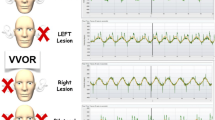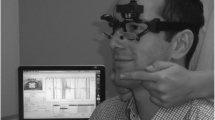Abstract
The head impulse test (HIT) can identify a deficient vestibulo-ocular reflex (VOR) by the compensatory saccade (CS) generated once the head stops moving. The inward HIT is considered safer than the outward HIT, yet might have an oculomotor advantage given that the subject would presumably know the direction of head rotation. Here, we compare CS latencies following inward (presumed predictable) and outward (more unpredictable) HITs after acute unilateral vestibular nerve deafferentation. Seven patients received inward and outward HITs delivered at six consecutive postoperative days (POD) and again at POD 30. All head impulses were recorded by portable video-oculography. CS included those occurring during (covert) or after (overt) head rotation. Inward HITs included mean CS latencies (183.48 ms ± 4.47 SE) that were consistently shorter than those generated during outward HITs in the first 6 POD (p = 0.0033). Inward HITs induced more covert saccades compared to outward HITs, acutely. However, by POD 30 there were no longer any differences in latencies or proportions of CS and direction of head rotation. Patients with acute unilateral vestibular loss likely use predictive cues of head direction to elicit early CS to keep the image centered on the fovea. In acute vestibular hypofunction, inwardly applied HITs may risk a preponderance of covert saccades, yet this difference largely disappears within 30 days. Advantages of inwardly applied HITs are discussed and must be balanced against the risk of a false-negative HIT interpretation.




Similar content being viewed by others
References
Halmagyi GM, Curthoys IS (1988) A clinical sign of canal paresis. ArchNeurol 45:737–739
Halmagyi GM, Aw ST, Cremer PD, Curthoys IS, Todd MJ (2001) Impulsive testing of individual semicircular canal function. AnnNYAcadSci 942:192–200
Weber KP, Aw ST, Todd MJ, McGarvie LA, Curthoys IS et al (2008) Head impulse test in unilateral vestibular loss: vestibulo-ocular reflex and catch-up saccades. Neurology 70:454–463
Newman-Toker DE, Saber Tehrani AS, Mantokoudis G, Pula JH, Guede CI et al (2013) Quantitative video-oculography to help diagnose stroke in acute vertigo and dizziness: toward an ECG for the eyes. Stroke 44:1158–1161
Kattah JC, Talkad AV, Wang DZ, Hsieh YH, Newman-Toker DE (2009) HINTS to diagnose stroke in the acute vestibular syndrome: three-step bedside oculomotor examination more sensitive than early MRI diffusion-weighted imaging. Stroke 40:3504–3510
Lee SH, Newman-Toker D, Zee SD, Schubert MC (2014) Compensatory saccade differences between outward versus inward head impulses in chronic unilateral vestibular hypofunction. J Clin Neurosci 21(10):1744–1749. doi:10.1016/j.jocn.2014.01.024
Hirvonen TP, Aalto H (2009) Three-dimensional video-oculography in patients with vestibular neuritis. Acta Otolaryngol 129:1400–1403
Newman-Toker DE, Kattah JC, Alvernia JE, Wang DZ (2008) Normal head impulse test differentiates acute cerebellar strokes from vestibular neuritis. Neurology. doi:10.1212/01.wnl.0000314685.01433.0d
EyeSeeCam (2013) VOG System. Munich, Germany
Agrawal Y, Schubert MC, Migliaccio AA, Zee DS, Schneider E et al (2014) Evaluation of quantitative head impulse testing using search coils versus video-oculography in older individuals. Otol Neurotol 35:283–288
Bartl K, Lehnen N, Kohlbecher S, Schneider E (2009) Head impulse testing using video-oculography. Ann N Y Acad Sci 1164:331–333
Mantokoudis G, Saber Tehrani AS, Kattah JC, Eibenberger K, Guede CI et al (2015) Quantifying the vestibulo-ocular reflex with video-oculography: nature and frequency of artifacts. Audiol Neurootol 20:39–50
Mantokoudis G, Schubert MC, Tehrani AS, Wong AL, Agrawal Y (2014) Early adaptation and compensation of clinical vestibular responses after unilateral vestibular deafferentation surgery. Otol Neurotol 35:148–154
Newman-Toker DE, Kerber KA, Hsieh YH, Pula JH, Omron R, et al (2013) HINTS outperforms ABCD2 to identify stroke in acute vestibular syndrome Atlanta, GA
Tarnutzer AA, Berkowitz AL, Robinson KA, Hsieh YH, Newman-Toker DE (2011) Does my dizzy patient have a stroke? A systematic review of bedside diagnosis in acute vestibular syndrome. CMAJ 183:E571–E592
Halmagyi GM, Black RA, Thurtell MJ, Curthoys IS (2003) The human horizontal vestibulo-ocular reflex in response to active and passive head impulses after unilateral vestibular deafferentation. Ann NYAcad Sci 1004:325–336
Della Santina CC, Cremer PD, Carey JP, Minor LB (2002) Comparison of head thrust test with head autorotation test reveals that the vestibulo-ocular reflex is enhanced during voluntary head movements. Arch Otolaryngol Head Neck Surg 128:1044–1054
Herdman SJ, Schubert MC, Tusa RJ (2001) Role of central preprogramming in dynamic visual acuity with vestibular loss. Arch Otolaryngol Head Neck Surg 127:1205–1210
Sprenger A, Zils E, Stritzke G, Kruger A, Rambold H et al (2006) Do predictive mechanisms improve the angular vestibulo-ocular reflex in vestibular neuritis? Audiol Neurootol 11:53–58
Goldberg JM, Minor LB (2012) Signal Processing in Vestibular Nuclei (VN) of Alert Animals during Natural Behaviors. The Vestibular System A Sixth Sense. Oxford University Press, Oxford
Schubert MC, Zee DS (2010) Saccade and vestibular ocular motor adaptation. Restor Neurol Neurosci 28:9–18
Tjernstrom F, Nystrom A, Magnusson M (2012) How to uncover the covert saccade during the head impulse test. Otol Neurotol 33:1583–1585
Mantokoudis G, Tehrani AS, Kattah JC, Eibenberger K, Guede CI, et al (2014) Quantifying the Vestibulo-ocular reflex with Video-Oculography: Nature and Frequency of Artifacts. Audiology & Neurolology: in press
MacDougall HG, Weber KP, McGarvie LA, Halmagyi GM, Curthoys IS (2009) The video head impulse test: diagnostic accuracy in peripheral vestibulopathy. Neurology 73:1134–1141
Weber KP, MacDougall HG, Halmagyi GM, Curthoys IS (2009) Impulsive testing of semicircular-canal function using video-oculography. Ann N YAcad Sci 1164:486–491
Acknowledgments
This study was supported by the Swiss National Science Foundation (PBBEP2 136573). The authors would like to thank Dr. Hergen Friedrich, MD, for the illustrations.
Author information
Authors and Affiliations
Corresponding author
Rights and permissions
About this article
Cite this article
Mantokoudis, G., Agrawal, Y., Newman-Toker, D.E. et al. Compensatory saccades benefit from prediction during head impulse testing in early recovery from vestibular deafferentation. Eur Arch Otorhinolaryngol 273, 1379–1385 (2016). https://doi.org/10.1007/s00405-015-3685-7
Received:
Accepted:
Published:
Issue Date:
DOI: https://doi.org/10.1007/s00405-015-3685-7




